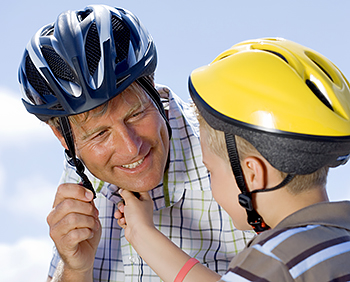May 2015
Adults: Be Safe When Biking
More Americans are rolling on 2 wheels these days. Biking is a healthy way to cruise around. Plus, more people are choosing to bike to work. But a recent report suggests safety may not always be a top priority for riders.

Deadly crashes
Experts from the Governors Highway Safety Association recently looked at the safety of biking in the U.S. They used data compiled over nearly 40 years from 1975 to 2012. They focused on deaths caused by bike and car crashes.
Over that time frame, they noted some telling changes. The number of fatal bike crashes was down overall up until 2010. They then found a 16% uptick. In the past most of the victims were children and adolescents. Now it’s adult males older than age 20. They are most often struck at intersections in urban areas.
What accounts for many of these deaths? Many riders weren’t wearing a helmet. As a result, they suffered a serious head injury. Nearly half of adult bicyclists forgo this safety measure. Alcohol was another major contributor. In 2012, nearly 3 out of 10 riders who died had blood alcohol levels above the legal limit of 0.08%.
Safety tips
The health benefits of biking certainly outweigh the risks. But you need to protect yourself while riding. Many bike accidents—particularly those involving cars—lead to head and upper body injuries.
Before you head out on the road or trail, follow these safety tips:
-
Check your bike’s condition. Test the brakes and make sure your tires are properly inflated.
-
Always obey the rules of the road. Like car drivers, bicyclists need to comply with traffic lights, stop signs, and other road markings. Ride your bike in the direction of moving traffic. Avoid unpredictable movements. And signal when you are changing lanes or turning.
-
Don’t drink and ride. Alcohol can impair your balance and reaction time. Also don’t use an electronic device, such as a cell phone, while biking. It can distract you from your surroundings.
-
Wear proper safety gear. That includes a well-fitted helmet. When riding at night, equip your bike with a headlight and a flashing rear light. You should also wear reflective or light-colored clothing.
Here are more biking tips.
Choosing a Bike Helmet
Not all states require bicyclists to wear a helmet. In fact many such laws apply to only children ages 16 and younger. But helmets save lives, especially in bike-car collisions.
When choosing a helmet for you or a loved one, make sure it fits right. Here’s how:
-
It should comfortably touch your head all the way around.
-
It should be level on your head.
-
It should extend as low as possible to help cover the sides of your head.
-
It should be stable enough to resist violent shakes or hard blows and stay in place.
-
It shouldn't rock back and forth more than an inch or so.
-
It should protect your forehead. The helmet should be only 1 to 2 finger widths above your eyebrows or eyeglass frames.
-
The straps should feel snug and comfortable.
Buy a helmet that has been approved by the U.S. Consumer Product Safety Commission. And if you are in a crash, replace it even if you don’t see any damage.
© 2000-2025 The StayWell Company, LLC. All rights reserved. This information is not intended as a substitute for professional medical care. Always follow your healthcare professional's instructions.